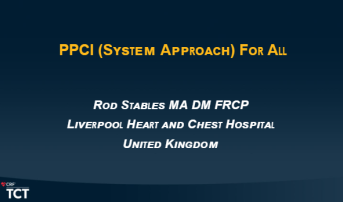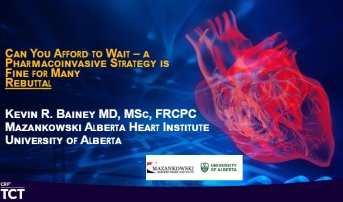Does Thrombolysis Have a Role in a Primary-PCI World? Experts Hash It Out
Thrombolysis is “fine” for many STEMI patients, says Kevin Bainey, but Rod Stables says its use excuses systematic failures.

SAN FRANCISCO, CA—Should all STEMI patients be treated with primary PCI or is thrombolysis a reasonable option for the majority of cases?
That was the question up for debate during the WorldLink Forum at TCT 2023, with Rod Stables, MD (Liverpool Heart and Chest Hospital, England), arguing that primary PCI should remain the gold standard for all STEMI patients and Kevin Bainey, MD (Mazankowski Alberta Heart Institute/University of Alberta, Edmonton, Canada), making the case that a pharmacoinvasive strategy is likely “fine” for many.
The reason that thrombolysis should remain a treatment option is that many healthcare systems can’t realistically revascularize STEMI patients in time, said Bainey. Even in the United States, “where there is a cath lab on every corner,” if patients present to a community hospital and require transfer to a PCI-capable center, just 17% are revascularized within the recommended 2-hour window from first medical contact to device implantation.
“If you don’t achieve that timely metric, mortality is exponentially higher,” said Bainey. “Even in the US, they’re not able to achieve timely primary PCI, so there has to be an alternative.”
In fact, during the COVID-19 pandemic, a time when primary PCI for all STEMI patients was a challenge to deliver, some experts argued that a fibrinolytic-based strategy might be reasonable to consider.
Stables wasn’t having any of it.
“All of us as weak human beings create excuses for our failings,” said Stables. “I have loads of highly plausible and cogent reasons for why I don’t train like I should, or why I eat poor food—I can make excuses for anything. But if you give yourself the excuse that your pharmaco-based therapy is all that you need, you never really will make an impact.”
At the end of the day, Stables said, where there’s a will, there’s a way to make timely primary PCI happen. The money is widely available in many hospitals to provide TAVI to 80-plus-year-old patients because it’s a big line item for hospitals. “It’s no good saying, ‘I can’t do it,’” he said. “Everything is about money.”
“If you want to improve outcomes, if you want to make a difference, you have to exert what they call in the military ‘concentration of force,’” continued Stables. “You put your resources where it counts. If you’re going to manage the people who are heading for an adverse event, you have to be able to provide the top-level response . . . . The only way you’re going to do that in an appropriately timely fashion is to create the infrastructure.”
‘Canadian-Like Challenge for Primary PCI’
Mina Madan, MD (Sunnybrook Health Sciences Center, Toronto, Canada), who moderated the debate, kicked off the session by highlighting the challenges of delivering care in Canada, a country of 40 million people second in landmass only to Russia. There are 49 hospitals with cardiac catheterization labs employing approximately 280 interventional cardiologists. Of the PCI-capable centers, 35 are in Ontario and Quebec, where roughly half the Canadian population resides, and 70% of hospitals perform more than 1,000 procedures each year.
“Our country is quite large so there is reduced access to cardiac services for people living in rural and northern communities,” said Madan. “Timely access to PCI or rescue PCI is not possible for some regions.”
In the UK with its roughly 70 million people, there are approximately 120 hospitals with cardiac catheterization labs and 750 interventional cardiologists who perform PCI. Daniel Blackman, MD (Leeds General Infirmary, England), who provided a snapshot of STEMI care in the UK, said that only half of these centers offer 24/7 primary PCI and that not all operators are part of a primary PCI rotation.
If you don’t achieve that timely metric [of 2 hours], mortality is exponentially higher. Kevin Bainey
Stables said that his hospital, located in the northwest, is in many ways an “ideal” primary PCI center, serving a population of 2.3 million people who live within 40 minutes of the hospital. However, they also face challenges with timely PCI, said Stables, pointing out that they also provide care for 85,000 people on the Isle of Man, which is located in the Irish Sea roughly 150 km from the mainland.
“They create a Canadian-like challenge for primary PCI,” Stables joked.
Citing data from some of the earliest trials, which included low-risk patients and highly motivated physicians, Stables said that TIMI-3 flow is not restored in all patients treated with thrombolysis. For example, normal flow was restored in just 50% to 60% of patients in the landmark TIMI-1 and GUSTO trials. In contrast, normal flow to the infarct-related artery with primary PCI is restored in 93% to 96% of STEMI patients. In 2003, a meta-analysis of 23 trials comparing primary PCI versus thrombolysis confirmed the superiority of the procedure, said Stables.
“Over the many trials, we see higher patency rates and more complete reperfusion resulting in smaller infarcts, better survival, a reduction in the major structural-type complications, more LV function downstream, and even reduced hospital stays,” said Stables. “What’s not to like? How can we not take this as our gold standard?”
Golden Hour With Thrombolysis
Bainey, on the other hand, argued that a pharmacoinvasive strategy is “here to stay,” citing a range of more contemporary clinical trials, including STREAM and STREAM-2, that compared fibrinolytic therapy with bolus tenecteplase against primary PCI in STEMI patients. In STREAM-2, for example, researchers showed that when timely PCI is not possible, a pharmacoinvasive strategy of half-dose tenecteplase was a safe and effective reperfusion alternative in older patients with STEMI.
Canadian registry data also showed that in patients selected for the pharmacoinvasive strategy fare better in terms of hard clinical outcomes (mortality, cardiogenic shock, heart failure, and reinfarction) when compared with those selected for primary PCI. The risks of intracranial hemorrhage were also low.
To TCTMD, Bainey said there are multiple barriers to patients undergoing coronary revascularization within the recommended 2-hour window. There are patient-related delays, such as a failure to recognize symptoms or activate emergency medical services (EMS), system-related delays, which can run the gamut from holdups in acquiring and interpreting the ECG to traffic and weather problems. Logistical problems can also occur in the cath lab, such as delays getting informed consent, vascular access, or stent deployment. Middle-of-the-night calls, for example, can pose challenges just getting the team assembled, he said.
Bainey also noted that there is a “golden hour” where patients do extremely well with fibrinolysis as part of a pharmacoinvasive strategy. If they get to hospital within 60 minutes of symptom onset, they have an excellent chance of “walking out of the hospital without any damaged myocardium,” he said.
If you can get an injured soldier off an active battlefield in Afghanistan and to a surgical hospital in 12 minutes, the Canadian healthcare system can cope. Rod Stables
“The majority of STEMI patients are presenting pretty early now with symptoms,” Bainey told TCTMD. “They’re not that sick. Those are the patients that benefit from a pharmacoinvasive approach. I’m the first to say we need both strategies. It’s not one size fits all, but rather thinking about the patient in front of you and deciding which patient strategy is best for them.”
One of the major issues that’s emerged with the dominance of primary PCI is that not everybody knows how to administer thrombolysis. Rasha Al-Lamee, MD, PhD (Imperial College London, England), said that many physicians at community hospitals would feel “undertrained” to administer thrombolysis or to make cardiology decisions.
“The pendulum has swung so far the other way that people have forgotten this life-saving therapy that was established in the 1980s,” Bainey told TCTMD. “Well, it’s a drug. It’s a dosing strategy. Just implement it—it’s way easier to implement than a fancy procedure. An ER doctor, a cardiologist, should be able to do this.”
Sanjog Kalra, MD (Toronto General Hospital/University Health Network, Canada), who spoke during the debate, said that in cities with world-class PCI-capable centers, traffic can be a bear, making it extremely difficult to get patients from an outlying community hospital to the cath lab in a timely way. “It’s why I think a prehospital thrombolysis piece, which we trialed in Calgary 15 years ago when I was a medical student, worked very well,” he said.
In Edmonton, where Bainey works, the Vital Heart Response Program allows EMS to administer thrombolysis following discussions with a cardiologist.
Stables acknowledged the golden hour, saying that thrombolysis is “unbelievably effective” if administered quickly within symptom onset. However, even prompt thrombolysis must be given within a functioning primary-PCI system because reperfusion may fail while others might have recurrent MI or other complications. Despite this, he remained unconvinced that patients can’t get to a PCI-capable hospital fast enough.
“If you can get an injured solider off an active battlefield in Afghanistan and to a surgical hospital in 12 minutes, the Canadian healthcare system can cope and so can we,” he said. “It’s about recognizing the real priorities.”
Michael O’Riordan is the Managing Editor for TCTMD. He completed his undergraduate degrees at Queen’s University in Kingston, ON, and…
Read Full BioSources
Stables R. How long can we wait for primary PCI in a transfer patient with STEMI. PRO: Primary PCI for all. Presented at: TCT 2023. October 25, 2023. San Francisco, CA.
Bainey K. How long can we wait for primary PCI in a transfer patient with STEMI. CON: You can afford to wait—a pharmacoinvasive strategy is fine for many. Presented at: TCT 2023. October 25, 2023. San Francisco, CA.
Disclosures
- Bainey and Stables report no conflicts of interest.







Comments